Open Journal of Accounting, 2017, 6, 82-94
http://www.scirp.org/journal/ojacct
ISSN Online: 2169-3412
ISSN Print: 2169-3404
The Relationship of Abnormal Audit Fees and
Accruals: Bargain Power or Cost Control?
Honghui Zhang
School of Accountancy, Jiangxi University of Finance and Economics, Nanchang, China
How to cite this paper: Zhang, H.H.
(2017) The Relationship of Abnormal Au-
dit Fees and Accruals: Bargain Power or
Cost Control? Open Journal of Accounting,
6, 82-94.
https://doi.org/10.4236/ojacct.2017.63007
Received: June 9, 2017
Accepted: July 2, 2017
Published: July 5, 2017
Copyright © 2017 by author and
Scientific Research Publishing Inc.
This work is licensed under the Creative
Commons Attribution International
License (CC BY 4.0).
http://creativecommons.org/licenses/by/4.0/
Open Access
Abstract
This paper uses the empirical data of listed companies in China from 2007 to
2013 to examine the relationships between abnormal audit fees and accruals
(audit quality), and tries to find out the mechanism and the consequences of
abnormal audit fees affecting accruals (audit quality). The research found that
abnormal audit fees were negatively correlated with accruals. After taking the
positive and negative nature of the abnormal audit expenses into considera-
tion, research found that the abnormal audit fee reflects the economic bond
between the auditor and the company, which impair the independence of au-
ditors and degrade the audit quality. Negative audit fees reflect strong bar-
gaining power of companies, and lower audit fees impel auditors to reduce
audit effort, control audit costs to achieve a certain profit target, which will
also degrade audit quality.
Keywords
Audit Fees, Abnormal Expenses, Auditors, Audit Quality
1. Introduction
The financial report auditing is the joint effort of the company and the auditor,
which requires the company, the auditor to negotiate and bargain in the course
of the audit [1]. Understanding the auditor’s compromise in audit quality is an
essential topic of concern to academics and practitioners. One possible explana-
tion is that the auditor’s employment and the audit fee payment depend on the
company. This economic dependency reduces the independence of auditor and
increases the likelihood of the auditors’ acquiescence of company’s earnings
management. However, the yield to the company’s requirements of earnings
management is costly; it may expand the legal risk of the entire firm, and even
lead to the churn of existing customer base. For example, “Enron events” led to
the churn of Anderson’s customer base, and finally collapsed; these contingent
DOI: 10.4236/ojacct.2017.63007 July 5, 2017
�
H. H. Zhang
audit risk requires the company to compensate the auditor, therefore audit fees
are at a premium. What’s more, audit fees may be given below normal levels.
Since companies have strong bargaining power, they are only willing to pay less
for audit fees [2]. Less audit fees will make auditors to reduce audit effort and
control costs to achieve necessary profits, which can result in the reduction of
audit quality.
As for study on audit fees, there has been a large amount of domestic re-
searches; a series of literature studied the influence factors and economic conse-
quences of audit fees. However, related researches on abnormal audit fees are
just at the initial stage. Based on the idea, Chen et al. [3] studied the relationship
between abnormal audit fees, adverse audit results improvement and audit opi-
nion shopping. However, domestic research focuses only on positive abnormal
audit fees, ignoring negative abnormal audit fees, and there are few researches
on the relationship between abnormal audit costs and audit quality. But these are
the emphasis of current foreign research [4]. Research from foreign scholar
shows that positive abnormal audit fees can impair the audit quality [5], negative
anomaly audit fees can also jeopardize audit quality [6]. To verify whether there
is such a situation in Chinese audit market, empirical data should be tested for
analysis.
Based on the empirical data of Chinese listed companies, this paper analyzes
the relationship between abnormal audit fees and audit quality. It is found that
the abnormal audit fees and the audit quality are negatively correlated. After
considering the positive and negative nature of the abnormal audit fees, result
shows that the independence of auditors can be decreased by abnormal audit
fees, and the auditor’s economic dependence on entrusting company leads to the
impairment of audit quality. Besides, negative abnormal audit fees reflect the
company’s strong bargaining power, but lower audit fees impel auditors to re-
duce audit efforts, control audit costs to ensure a certain profit, which will also
jeopardize the audit quality. This paper studies audit quality from the perspec-
tive of abnormal audit fees, expands the literature of abnormal audit fees and
audit quality, which gives reference to the improvement of the audit fee rule.
2. Literature Review and Assumptions
The study of audit fees mainly focuses on its influencing factors, such as corpo-
rate-level factors and firm-level factors, to examine the impact of these factors
on audit fees. Simunic [7] innovatively pointed out that audit fees are related to
factors such as company scale, financial leverage, and inventory. Subsequently,
some scholars extended the research on audit fees to the audit committee, inter-
nal control [8], firm consolidation and other fields. Domestic research on audit
fees also started with corporate-level factors and firm-level factors. As for cor-
porate-level factors, Zhang [9] found companies’ own asset scale is one of the
main factors affecting the audit fees. Other research studied audit fees based on
factors such as corporate governance, internal control. For the firm’s level, Li et
al. [10] studied the impact of the firm’s merger on audit fees; Liu studied the
83
�
H. H. Zhang
84
impact of firm’s being punished on audit fees. Other research studied the issue
of audit fees from the perspective of media attention, product market competi-
tion.
Existing domestic literature is more concerned about audit fees, but seldom
focuses on the abnormal audit fees. Auditors may receive audit fees under nor-
mal level when providing audit services and may also charge too high a fee.
However, overseas scholars have already made research on abnormal audit fees,
such as DeAngelo [11] pointed out that the auditor is economically dependent
on their customer, and they may maintain good relationship with their customer
to obtain “quasi-rents”, such that the independence of the auditors are jeopar-
dized by abnormal audit fees , finally negatively influence the audit quality. After
that, a series of studies explored the impact of abnormal audit fees on audit qual-
ity, there was no significant relationship between abnormal audit fees and audi-
tors’ going concern opinion. Larcker and Richardson [12] used the data from
2000-2001 to study the relationship between audit quality (absolute value of the
discretionary accruals ) and abnormal audit charges, and found that the increase
of abnormal audit fees led to a decline in audit quality. Chen [3] argues that an
increase in abnormal audit charges will lead to an improvement in adverse audit
results and an increase in audited accounting earnings. Fang and Hong [13] also
found that abnormal audit is positively related to the improvement of adverse
audit results, and the company’s audit opinion changes from adverse opinion or
disclaimer of opinion to current year’s other types of audit opinion. Based on the
above analysis, the hypothesis 1 is proposed.
Hypothesis 1: Ceteris paribus, the higher the abnormal audit costs, the lower
the audit quality.
Although the above-mentioned domestic studies suggest that changes in ab-
normal audit fees may lead to opinion shopping and other acts, but ignore the
positive and negative nature of audit fees. Foreign literature has already studied
its influence on audit quality. For positive abnormal audit fees, general studies
have argued that economic dependence on entrusting companies leads auditors
to abandon the implementation of adequate professional prudence to correctly
interpret audit evidence or to make impartial judgments. Excessively high ab-
normal audit fees will lead to a decrease in the auditor independence. Audit fee
beyond normal level was given by companies to make auditors acquiesce its
earnings management, which will finally affect audit quality. Krishnan et al. [5]
found that there was a significant negative correlation between abnormal audit
fees and earnings response coefficients, indicating that abnormal audit fees
would affect audit quality negatively. Hribar et al. [14] found that abnormal au-
dit fees are positively correlated with financial restatement, accounting malprac-
tice, and SEC comments letter during 2002 to 2007. The above studies are all
discussing the impact of positive abnormal audit fees on audit quality. For nega-
tive abnormal audit fees, Asthana and Boone [6] argue that negative abnormal
audit fees reflect the company’s bargaining power, and it is negatively correlated
with audit fees. The bargaining power mainly affects companies’ audit quality
�
H. H. Zhang
from the following two aspects: on the one hand, since financial report auditing
is the result of the bargaining of the auditor and the company, the company will
use its own bargaining power to implement earnings management in a certain
degree without violating the GAAP, and the stronger the company’s ability to
bargain, the greater the degree of earnings management, which will ultimately
lower the quality of the audit. On the other hand, excessive low audit fees will
impel the auditor’s to reduce audit effort and cut necessary audit procedures,
which severely damaged audit quality. Blankley et al. [15] also found that exces-
sive low audit fees dampen audit efforts and are more likely to cause financial
restatements. Based on the above analysis, Hypothesis 2a and 2b are proposed.
Hypothesis 2a: Ceteris paribus, the higher the abnormal audit fees, the lower
the audit quality.
Hypothesis 2b: Ceteris paribus, the higher the negative abnormal audit fees,
the lower the audit quality.
3. Research Design
3.1. Data Sources and Data Filtering
This paper uses the China CSMAR database to collect the financial data and au-
dit data of China listed companies from 2007 to 2013. After obtaining the data of
all listed companies in the database, the following screening procedures are im-
plemented: (1) Remove listed companies with incomplete annual data from 2003
to 2007. (2) Remove listed companies that issue B shares or H shares simulta-
neously. These companies’ research results may be alienated because they are
multiply supervised. (3) Remove listed companies that are categorized as ST, PT
in certain year or continuous year. (4) Remove companies with abnormal indi-
cators. Whether the accountancy firm is big10 is the control variables in this ar-
ticle and the data are obtained from the CICPA’s firm ranking. The final number
of samples is 9959. Table 1 shows the definition of variables.
3.2. Regression Model
There are two ways to measure the amount of abnormal audit fees, one is to es-
tablish the expected audit fees model, and use the regression residuals to indicate
abnormal audit fees, such as, Asthana and Boone, Blankley et al., etc.; the other
is to examine the annual changes of audit fees, and use the changes to indicate
abnormal audit fees, such as Fang and Hong. In this paper, we use the former
method to measure the abnormal audit fees, and the former one to do robust-
ness check.
Lnfee
=
β β
1
+
+
0
Sqsub
β
7
Big10
+
+
β
8
Op
β
2
Roa
+
Rec
Inv
β
+
β
+
4
3
Sale
Lev
+
β
β
10
9
+
+
β
5
β
11
+
Em
β
6
Ind/Year
Chang
κ
+
(1)
In the above model, Lnfee represents the audit fee, expressed in natural loga-
rithm; Big10 is the dummy variable of “the top 10 firm”, when the firm belongs
to Big ten, its value is 1, otherwise 0; Op represents the audit opinion, the mod-
ified audit opinion is 1, otherwise 0; Inv is the inventory level, with the inventory
85
�
H. H. Zhang
86
Table 1. Definition of variables.
Variable type Variable name
Variable interpretation
Dependent
variables
Independent
variables
Control
variables
|Da|
Cscore
Lnfee
Resfee
Dlnfee
Big10
Op
Inv
Rec
Em
Change
Sqsub
Roa
Lev
Sale
Audit quality, the absolute value of earnings
management level, calculated according to Dechow et al.
Audit quality, indicated by accounting conservatism, which is
calculated by the model of Khan and Watts [17]
Audit fees, expressed in natural logarithm
Abnormal audit fees, the residual of the model (1)
Abnormal audit fees, annual change value of natural logarithm
Dummy variables of Big ten, it is 1 when the firm is big ten;
otherwise 0.
Audit opinion. 1 for modified audit opinion, 0 otherwise.
Inventory level. Inventory divided by total asset.
Account receivable level. Account receivable divided by the total
assets.
Earnings management tendency. 1 for the occurrence of annual
loss last year, 0 otherwise.
Firm change, 1 for the occurrence of firm change, 0 otherwise
The complexity of audit service, indicated by the number of
company segments.
Profitability, measured by company’s return on total assets.
Financial leverage, measured by asset-liability ratio.
Company scale, measured by the natural logarithm
of sales revenue.
divided by the total asset; Rec represents accounts receivable, with accounts re-
ceivable divided by the total asset; Em represents earnings management tenden-
cies, its value is 1 when company suffer annual losses last year, , Otherwise 0;
Change indicates the firm changes, if changed, the value is 1, otherwise 0; Sqsub
shows the complexity of audit service, it calculated as the square root of the
number of company segments; Roa is the company’s total return on assets; Lev
is the company’s asset-liability ratio; Sale is the natural logarithm of the compa-
ny’s sales revenue; Year is the annual dummy variable; Ind is the industry dum-
my variable. The regression residual of the model (1) indicates abnormal audit
fees, named as Resfee.
Da
=
α α
+
0
1
Roa
α
+
5
Resfee
α
6
+
Big10
+
α
2
Lev
+
α
7
Inv
α
+
3
Cashf
+
α
8
Sqsub
α
+
4
Ind/Year
+
(2)
θ
In this model, |Da| is the absolute value of the earnings management level, it is
calculated according to the method of Dechow et al. [16], which represents the
audit quality; Resfee is the abnormal audit fees, calculated according to model
(1); the other variables are interpreted in the same way as the above-mentioned.
3.3. Descriptive Statistical Analysis and Univariate Analysis
Before implementing empirical analysis, the main continuous variables are win-
sorized. As it is shown in Table 2, |Da| represents audit quality, which is the
�
H. H. Zhang
Table 2. Descriptive statistics.
Variable
|Da|
Resfee
Lnfee
Lev
Roa
Cashf
Inv
Big10
Sqsub
Em
Rec
Change
Op
Dlnfee
Cscore
Mean
0.2145
0
13.4891
0.4786
0.0678
0.0443
0.1774
0.4549
2.1571
0.0791
0.0912
0.1116
0.0304
0.1045
0.0112
Median
0.0880
−0.0791
13.3342
0.4906
0.0707
0.0443
0.1339
0
2
0
0.0618
0
0
0
0.0109
Std. error
Minimum
Maximum
0.3768
0.6637
0.7647
0.2087
0.1209
0.0784
0.1662
0.4980
0.6218
0.2699
0.0939
0.3149
0.1717
0.2573
0.0879
6.87e−07
−4.1199
9.2103
0.0518
−0.5857
−0.2034
0
0
1
0
0
0
0
−4.2812
−0.5919
2.0771
4.2135
18.3694
0.9164
0.3765
0.2581
0.9426
1
7.6811
1
0.6776
1
1
5.2470
0.4247
absolute value of earnings management level, the maximum value of |Da| is 2.0771
and the minimum is close to 0. Resfee represents abnormal audit fees, with the
maximum value of 4.2135 and the minimum value of −4.1199, indicating that
some firms charge higher than expected levels of audit fees, while some compa-
nies are below expected levels. The result of Lnfee for audit fees varies greatly,
with a maximum of 18.3694, a minimum of 9.2103 and a standard deviation of
0.7647. In other variables, Sqsub for the complexity of the audit business has ob-
vious otherness, with a standard deviation of 0.6218 and Cscore has a maximum
of 0.4247, a minimum −0.5919 and a mean of 0.0109, which is less than the
mean in Khan and Watts (2009), indicating that the accounting conservatism of
listed companies in our country is less than that of US listed companies.
In Table 3, according to the median of the abnormal audit fees (Resfee and
Dlnfee), sample companies were divided into two sub-samples, which were low-
er than the median and higher than the median. For |Da| it can be seen that,
Resfee sample with high abnormal audit fee has higher mean and median than
the low, and it also has highly significant T-statistic of −4.4790 and Wilcoxon
signed rank test value of −5.154, indicating that there are significant differences
between different abnormal audit fees samples. As for the audit quality ex-
pressed in Cscore, the accounting conservatism of the high Resfee samples has
negative mean and median, suggesting that sample companies with high abnor-
mal audit fee do not have conservatism. Accordingly, the positive mean and me-
dian of the low Resfee samples’ accounting robustness undoubtedly indicate that
sample firms with low abnormal audit fees have accounting conservatism, and
the T test value and the Wilcoxon signed rank test value are highly significant.
87
�
H. H. Zhang
88
Similarly, in the two sub-samples of Dlnfee , the mean and median value of the
high Dlnfee samples were higher than those of the low, and the T-statistic and
the Wilcoxon signed rank test also were highly significant. The differential test
in Table 3 shows that there is a significant difference in companies’ audit quality
under different levels of abnormal audit fees, which initially confirms our hypo-
thesis.
4. Regression Analysis
In order to verify the hypothesis of this paper, regression is performed according
to the regression model (2). The results are as follows. In Table 4, the regression
(1) considers the influence of abnormal audit fees plus the company’s financial
indicators on the audit quality. In this regression, the regression coefficient of
the abnormal audit fees (Resfee) is 0.0719, which is highly significant, indicating
that an increase of 1% of the abnormal audit fee will lead to |Da|’s growth of 7.19
percent. Since the dependent variable |Da| is the inverse indicator of the audit
quality, the economic meaning of the regression (1) is that the audit quality is
reduced by 7.19% for every 1% increase of the abnormal audit fee, which verifies
the hypothesis 1. The regression (2) considers the impact of abnormal audit fees
plus the audit-related indicators on the audit quality. The regression coefficient
of the abnormal audit fee is 0.0719, with high significance at 1 percent, and the
regression result is consistent with the regression (1), confirming the hypothesis
1. In regression (3), all variables were put into the regression equation, and the
regression coefficient of Resfee is 0.0719 and is highly significant, which is also
consistent with the previous regression (1), regression (2), similarly confirms the
hypothesis 1. However, the control variables vary in regression (1), regression
(2) and regression (3), which directly results in the difference between the F-
statistic and the coefficient of determination in the regression model. In regres-
sion (4), the independent variable is positive abnormal audit fees, with a highly
significant regression coefficient of 0.0736, indicating that the positive abnormal
audit fees lead to a decline in corporate audit quality, which confirms the hypo-
thesis 2a of this paper. It also suggests that companies impair the auditor’s
Table 3. Differences in audit quality under different standards.
High Resfee
Low Resfee
t-statistic
Wilcoxon
Audit quality
Da
Mean
0.0311
Median Mean Median
0.0161
−0.0085
0.0054
−4.4790***
−5.154***
High Resfee
Low Resfee
Audit quality
Cscore
Mean
Median Mean Median
−0.0187
−0.0185
0.0405
0.0371
25.4984***
24.456***
High Dlnfee
Low Dlnfee
t−statistic
Wilcoxon
Audit quality
Da
Mean
0.0291
Median Mean Median
0.0151
−0.0176
0.0045
−5.1395***
−5.762***
Note: Significance (two-tailed) at: *0.10, * *0.05 and ***0.01 levels, respectively.
�
Table 4. Abnormal audit fees and audit quality.
H. H. Zhang
Resfee
Lev
Roa
Cashf
Big10
Inv
Sqsub
con
Ind
Year
f
adj
n
All Resfee
All Resfee
All Resfee
Resfee > 0
Resfee < 0
(1)
0.0719***
(13.41)
0.3053***
(16.41)
0.1417***
(4.55)
0.0333
(0.67)
−0.0676***
(−3.11)
control
control
54.15***
0.1425
9599
(2)
0.0719***
(13.24)
0.0211***
(2.83)
0.0479*
(1.66)
0.0213***
(3.62)
0.0578**
(2.54)
control
(3)
(4)
(5)
0.0719***
(13.42)
0.3096***
(16.13)
0.1470***
(4.69)
0.0105
(0.21)
0.173**
(2.35)
−0.0657**
(−2.19)
0.125***
(2.14)
−0.0929***
(−3.77)
control
0.0736***
(6.49)
0.4061***
(11.72)
0.2164***
(4.01)
0.0708
(0.76)
0.0185
(1.37)
−0.0645
(−1.20)
0.0185
(1.37)
−0.1779***
(−4.15)
control
0.0384***
(2.83)
0.2104***
(9.40)
0.1007***
(2.76)
−0.0648
(−1.17)
0.0157*
(1.80)
−0.0742**
(−2.21)
0.0062
(0.94)
−0.0191
(−0.67)
control
control
44.54***
0.1198
9599
control
49.73***
0.1435
9599
control
28.33***
0.1759
4228
control
19.26***
0.1009
5371
Notes: Significance (two-tailed) at: *0.10, * *0.05 and ***0.01 levels, respectively.
independence by paying auditors positive abnormal audit fees to satisfy the
earnings management objectives. In regression (5), the independent variable is
negative abnormal audit fees, with a significant regression coefficient of 0.0384,
indicating that negative abnormal audit fees also lead to a decline in corporate
audit quality, which well confirms the hypothesis 2b, verifies that excessively low
audit costs impel auditors to reduce audit effort and finally jeopardize audit
quality. This regression result also confirms the impact of companies’ bargaining
power on audit quality. The conclusion of regression (4) and regression (5) is
consistent with that of Asthana and Boone (2012), therefore this paper argues
that abnormal audit fees will reduce audit quality for Chinese listed companies.
In the control variables, the financial leverage (Lev) and the audit quality is
negatively correlated. The cash return rate (Roa) has a negative correlation with
the audit quality. Cashflow (cashf) has no significant correlation with the audit
quality. The regression coefficients of the big 10 firm (Big10) are positive and
significant; the regression coefficient of stock level (Inv) is negatively significant;
the complexity of audit services (Sqsub) has a negative correlation with audit
quality.
5. Robustness Test
5.1. Variable Substitution
In order to verify the robustness of the conclusion, dependent variables |Da|
89
�
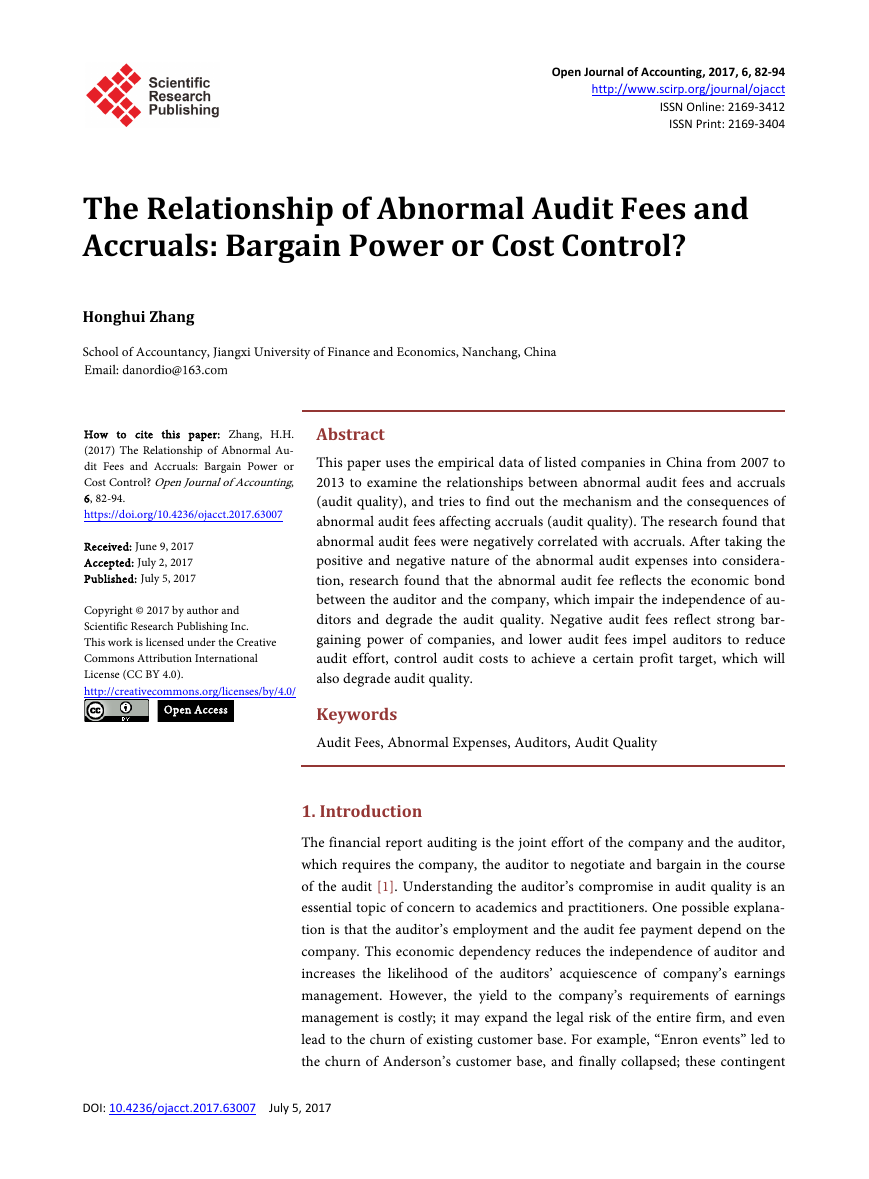
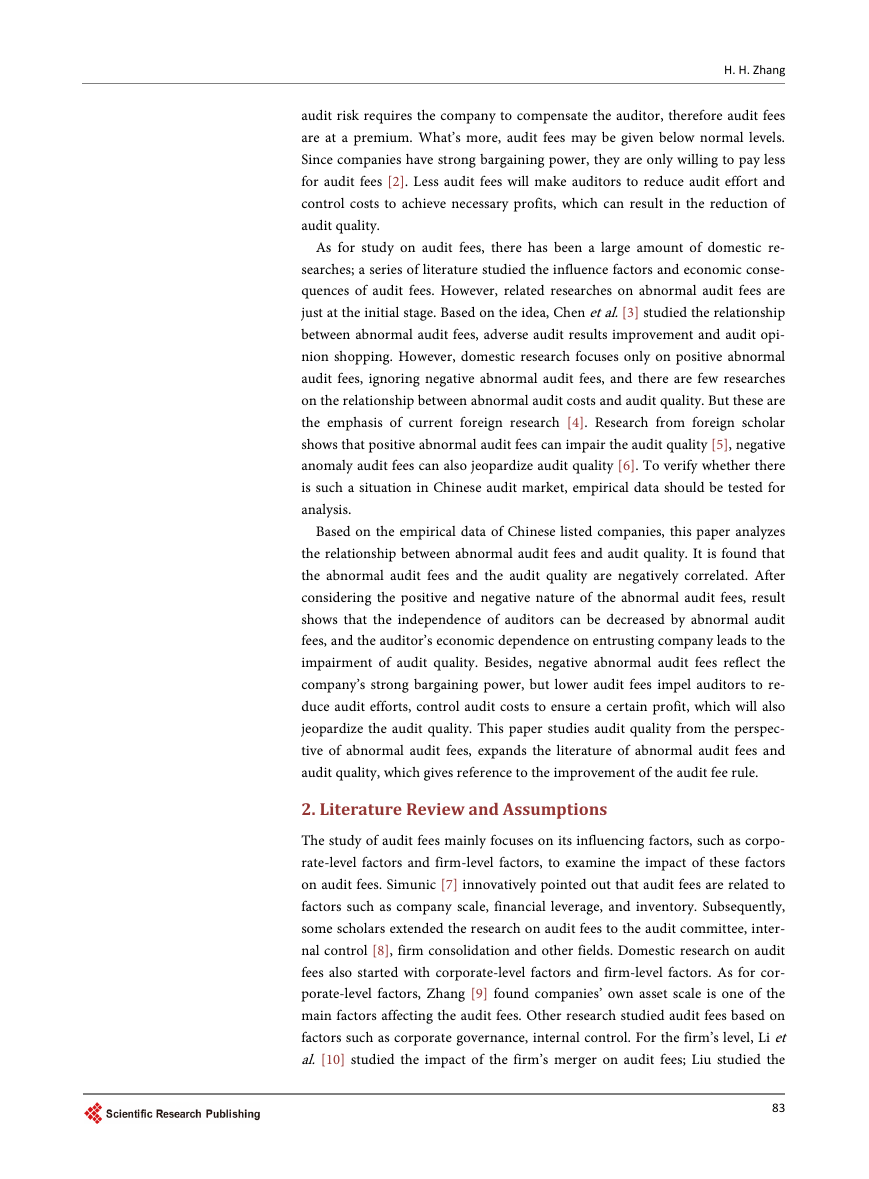
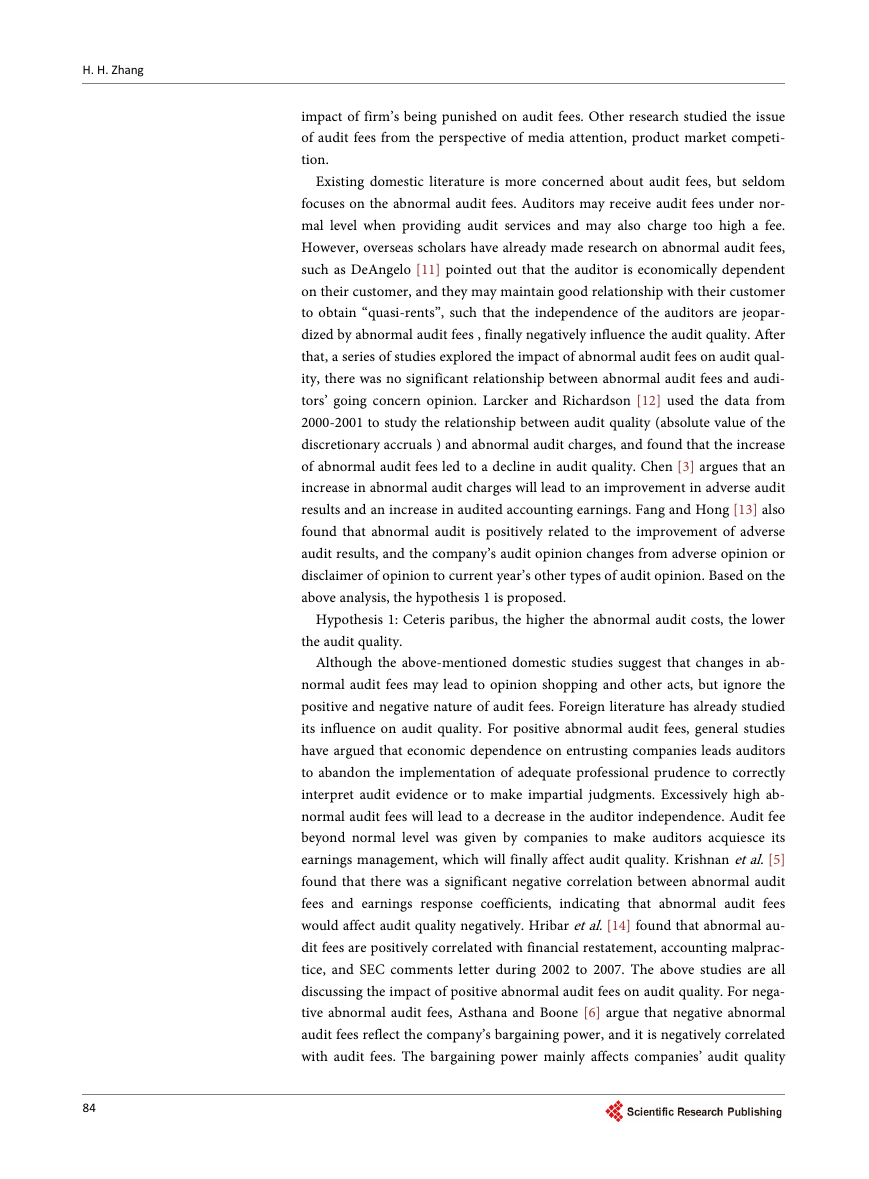
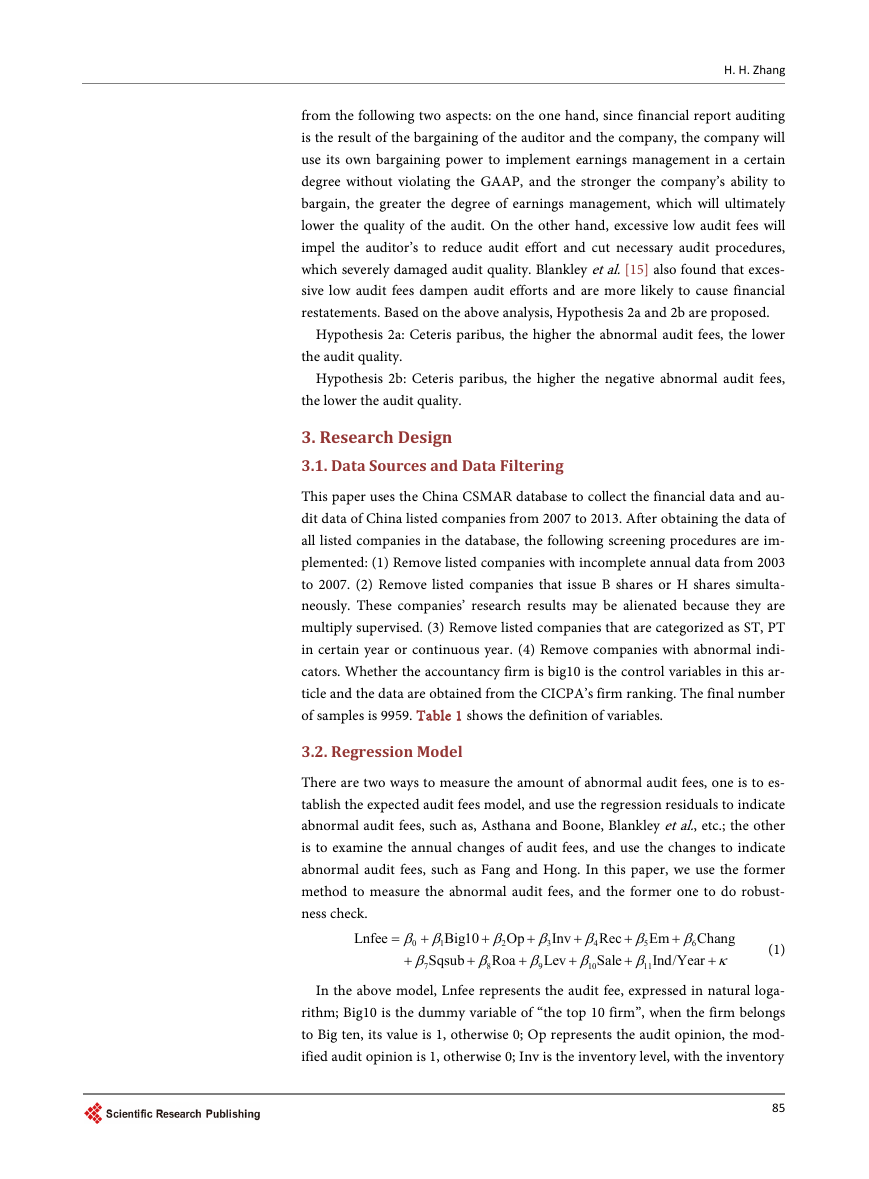
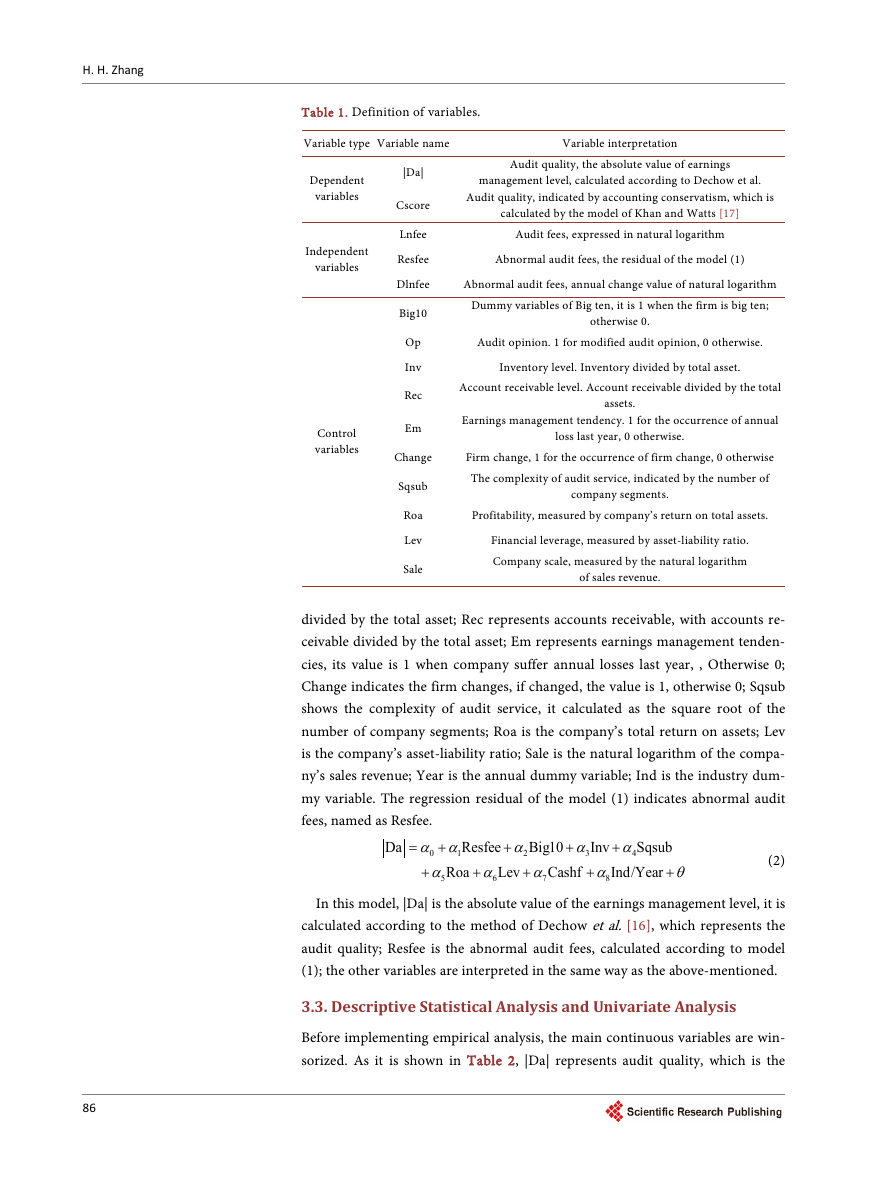

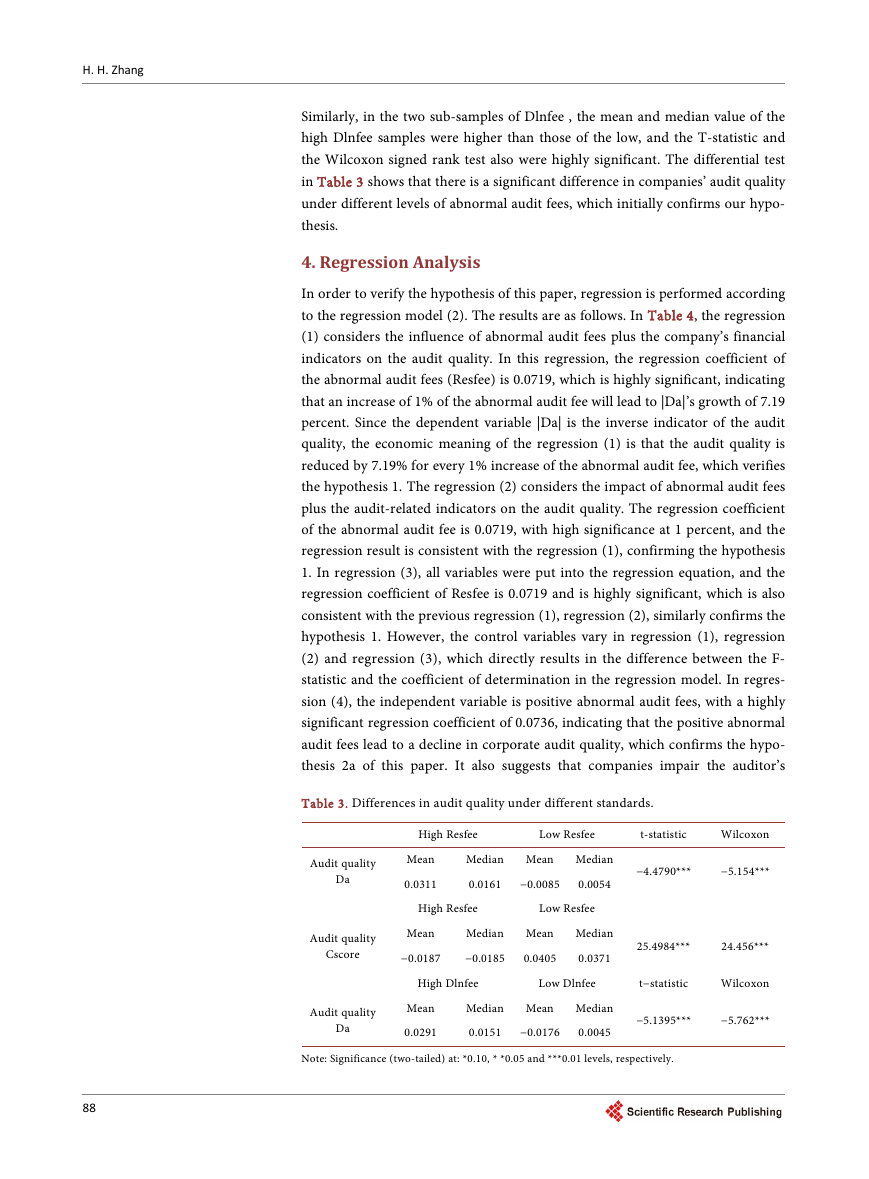
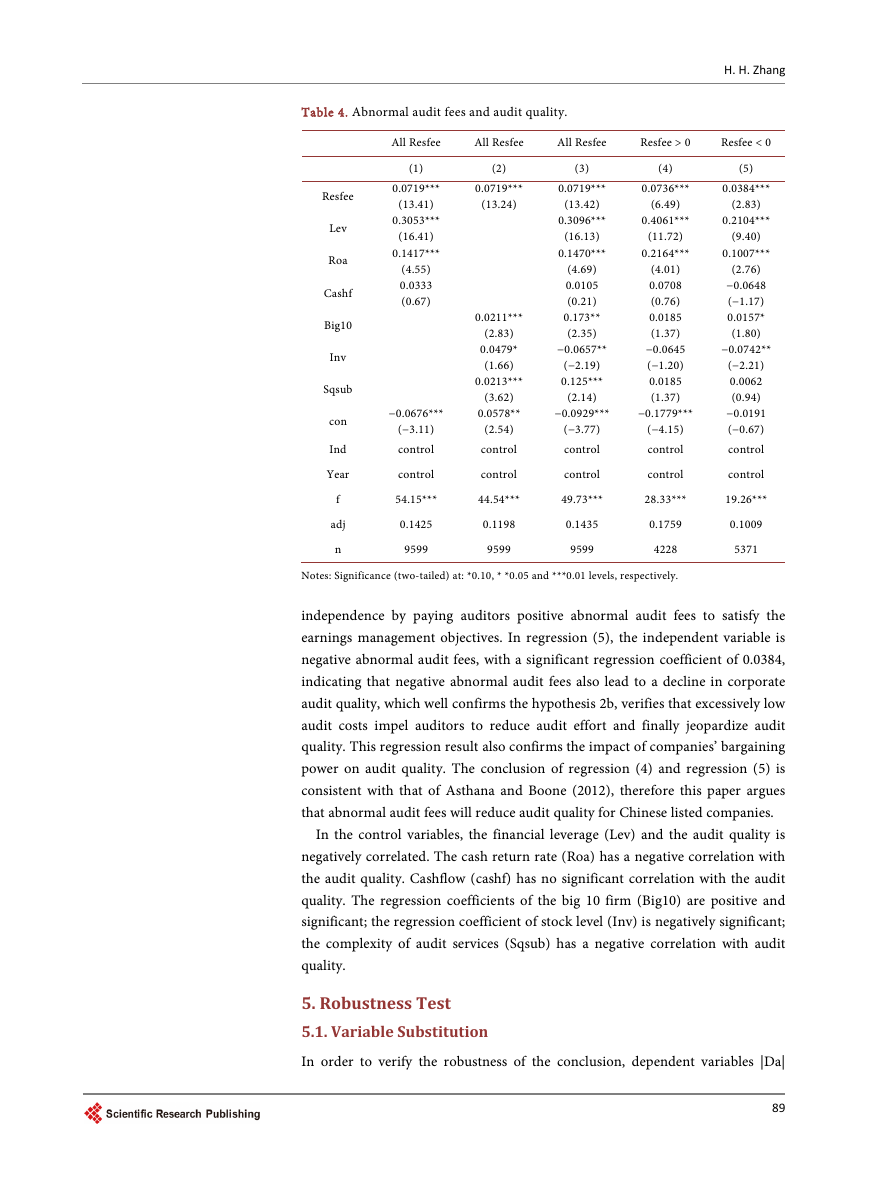








 2023年江西萍乡中考道德与法治真题及答案.doc
2023年江西萍乡中考道德与法治真题及答案.doc 2012年重庆南川中考生物真题及答案.doc
2012年重庆南川中考生物真题及答案.doc 2013年江西师范大学地理学综合及文艺理论基础考研真题.doc
2013年江西师范大学地理学综合及文艺理论基础考研真题.doc 2020年四川甘孜小升初语文真题及答案I卷.doc
2020年四川甘孜小升初语文真题及答案I卷.doc 2020年注册岩土工程师专业基础考试真题及答案.doc
2020年注册岩土工程师专业基础考试真题及答案.doc 2023-2024学年福建省厦门市九年级上学期数学月考试题及答案.doc
2023-2024学年福建省厦门市九年级上学期数学月考试题及答案.doc 2021-2022学年辽宁省沈阳市大东区九年级上学期语文期末试题及答案.doc
2021-2022学年辽宁省沈阳市大东区九年级上学期语文期末试题及答案.doc 2022-2023学年北京东城区初三第一学期物理期末试卷及答案.doc
2022-2023学年北京东城区初三第一学期物理期末试卷及答案.doc 2018上半年江西教师资格初中地理学科知识与教学能力真题及答案.doc
2018上半年江西教师资格初中地理学科知识与教学能力真题及答案.doc 2012年河北国家公务员申论考试真题及答案-省级.doc
2012年河北国家公务员申论考试真题及答案-省级.doc 2020-2021学年江苏省扬州市江都区邵樊片九年级上学期数学第一次质量检测试题及答案.doc
2020-2021学年江苏省扬州市江都区邵樊片九年级上学期数学第一次质量检测试题及答案.doc 2022下半年黑龙江教师资格证中学综合素质真题及答案.doc
2022下半年黑龙江教师资格证中学综合素质真题及答案.doc